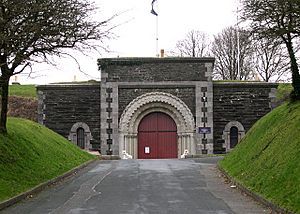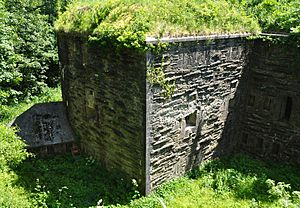Crownhill Fort facts for kids
Crownhill Fort is a huge old fort built in the 1860s in Crownhill, Plymouth. It was part of a ring of strong defences planned by Lord Palmerston. These forts were made to protect Plymouth from possible attacks.
Today, the Landmark Trust has brought the fort back to life. It now has small businesses, museums, and even a holiday apartment. You can visit the fort on the last Friday of each month. It also offers special tours for schools and groups.
Contents
The Fort's Story: A Look Back in Time
Crownhill Fort was designed by Captain Edmund Frederick Du Cane. It was one of the last forts built for Lord Palmerston. Its main job was to protect the important Royal Dockyard at Devonport. This was because people worried about a possible attack from France in the 1800s.
Building the fort started in April 1863. It was very modern for its time. The fort has a special seven-sided shape and was built on a natural hill. This made it easy to defend from all directions. It had strong walls and a deep ditch all around it. There were also about 350 small openings for rifles. The fort was planned to hold 32 large guns and 6 mortars. A Russian general named Todleben even praised the building work in 1864.
In 1866, the company building the fort ran into trouble. So, the Royal Engineers finished the work. They also became the fort's first occupants. The fort cost about £76,409 to build. This was a lot of money back then!
Over time, weapons changed a lot. Many old forts were no longer needed by the army. But Crownhill Fort stayed important. It was used by the MOD until 1986. Many different army groups used it as their main base in Plymouth.
During the First World War, the fort was a busy place. It helped recruit soldiers and send them to places like Turkey and Africa. After the war, it became a base for the new Royal Signals Corps.
The fort was last armed during the Second World War. Anti-aircraft guns were placed there to protect the area from planes. In the 1950s, a special room for gun operations was built. The fort continued to be a home for the 59 Independent Commando Squadron Royal Engineers until 1983. They even sent troops and supplies during the Falklands War.
Three years later, in 1986, the Landmark Trust bought the fort. They have worked hard to restore it. Today, Crownhill Fort is one of the best-preserved examples of Palmerston's forts.
How Crownhill Fort Was Built
Crownhill Fort has a unique seven-sided shape, like a heptagon. It shows off many clever ideas from Victorian fort design.
The Deep Ditch
A dry ditch surrounds the fort. It was dug right out of the solid rock. To make this ditch, workers had to move 200,000 tonnes of material! The ditch is about 30 feet deep and 30 feet wide.
The Caponiers: Guard Towers
Crownhill Fort has six special structures called caponiers. These are like guard towers with three levels.
- The first level was for soldiers with rifles.
- The second level held guns that could fire through openings.
- The third level connected to a walkway around the fort's top edge.
One caponier, the north one, is a "full caponier." This means it could fire in two directions. The other five are "demi-caponiers," firing in only one direction.
Crownhill Fort's Amazing Guns
Crownhill Fort is well-known for its collection of old artillery. The cannons are kept in working order. They are fired on special event days to show what a working fort sounded like.
The fort has spots for 17 guns on its main walls. It also has 15 guns in its caponiers. Some of the cool guns you can see include:
- A working replica of a Moncrieff Counterweight Disappearing Gun. This gun uses a clever system to pop up, fire, and then drop back down.
- Two large 13-inch Mortars. These were designed to fire heavy 200-pound explosive shells. They might have been used in the Crimean War.
- Two 32-pounder smooth-bore breech-loading guns from the 1880s.
- Four replica 32-pounder smooth-bore guns made in 1997.
- Two replica Armstrong 7-inch rifled breechloaders. These guns were first used by the navy but later moved to forts like Crownhill.
- Two 32-pounder guns that load from the front. These were saved from Tregantle Fort where they were being used as posts.
- A small 2-pound cannon from the 1790s.
- A carronade made by Bailey, Pegg and Co Ltd.
Crownhill Fort Today: What's Happening Now
Today, Crownhill Fort is a lively place. It hosts several small businesses and a holiday apartment. You can visit the fort on the last Friday of each month, from January to November. Schools and groups can also arrange visits at other times.
Visitors can explore museum displays and watch demonstrations of Victorian firepower. You can also take guided tours through the many underground rooms and passages.
The Landmark Trust has been busy making improvements at the fort.
- In 2010, many large trees were removed from the fort's walls by helicopter. These trees could have damaged the old structures.
- By 2014, a three-year project finished clearing young trees from the outer walls.
- In 2017, work was completed to clear old Victorian storm drains. This helps stop flooding in the lower parts of the fort.
- In 2018, outside the fort, concrete fence posts from the 1920s were fixed and their wiring replaced.
- Work on the Royal Artillery Store began in September 2018. This project turned an old, unused building into a workshop.



